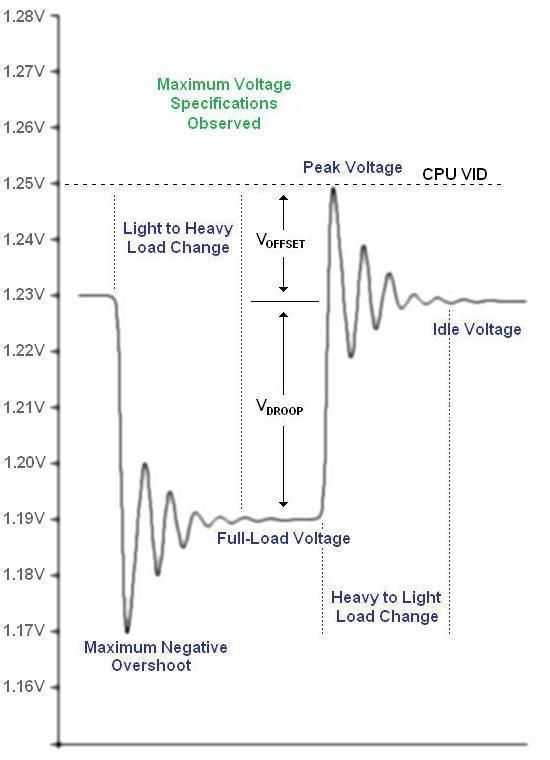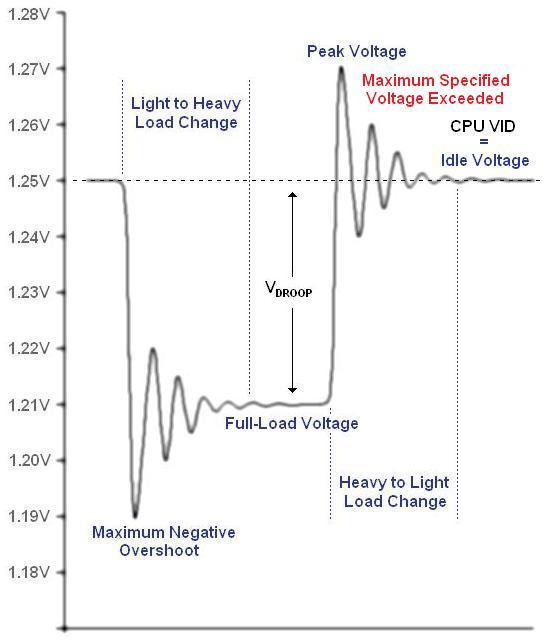Overclocking Intel's New 45nm QX9650: The Rules Have Changed
by Kris Boughton on December 19, 2007 2:00 AM EST- Posted in
- CPUs
Intel Processor Power Delivery Guidelines
If you've ever overclocked a system, chances are that at some point or another you've had opportunity to become upset with your Vdroop "problem." Some users, confused as to why their system refuses to exactly match actual processor supply voltage to the value specified in BIOS, are quick to blame the quality their motherboard; still others find fault with the difference noted between their board's idle and full-load processor supply voltages. Actually, load line droop (Vdroop) is an inherent part of any Intel power delivery design specification and serves an important role in maintaining system stability. In most cases, comments regarding unacceptable power delivery performance are completely unfounded. To make matters worse, unjustified negative consumer perception surrounding this often misunderstood design feature eventually forced a few motherboard manufacturers to respond to enthusiasts' demands for action by adding an option in their BIOS that effectively disables this important function.
Based on the currently running tasks, processor load can vary significantly during system operation. The voltage regulator module (VRM) circuit closely regulates CPU supply voltage by sensing instantaneous changes in processor loading and then responds by varying the individual on-time for a bank of power MOSFETs used to charge a multi-phased LC network. This LC network is responsible for providing all of the power demanded by the processor. If the VRM senses a decreasing supply voltage, it provides more current; the opposite is true in the case where voltage is rising. This cycle of sense-and-correct, known as negative feedback, can occur at that rate of thousands to millions of times per second, depending on the particular circuit's switching frequency.

Just like CPU power, CPU supply current increases quickly at higher frequencies
During periods of high CPU demand, the VRM circuit works hard to supply the current required by the processor. However, as soon as that load is gone, the VRM circuit must act quickly in order to reduce the current supply to the level needed to match the new demand. Because it's impossible for the VRM circuit to respond instantaneously, the larger the load change the greater the maximum potential peak overshoot voltage. Controlling the magnitude of these peak values is critical for maintaining system stability. By positioning the processor's no-load (idle) voltage level higher during periods of light loading, it's possible to sustain a larger negative voltage dip without crossing the processor's lower specified voltage limit. In addition, "drooping" the load voltage as a function of supply current allows the VRM to effectively limit the maximum positive peak overshoot voltage (experienced during a heavy to light load transient) to a value below the maximum allowable CPU voltage. This resulting control system ensures the processor supply voltage, regardless of CPU load, never violates a specified limit. The following figure should help to illustrate these concepts.

As intended, Voffset and Vdroop ensure that the supply voltage never exceeds CPU VID
The CPU VID setting establishes the absolute maximum allowable processor supply voltage experienced during transient conditions and is not the target idle voltage. We hope this statement draws attention to this important distinction, as many believe the opposite to be true - a mistake all too commonly made. Together, Vdroop and Voffset ensure that the peak CPU supply voltage seen during heavy to light loading changes remains well below the established maximum. If you determine that 1.17V, as in the case above, is not sufficient for maintaining CPU stability under load, simply increasing the CPU VID does correct the problem. Let's now examine how the system responds if we remove Voffset.

Voltage oscillations while leaving heavy load can cause problems with no Voffset
As we can see, the system exceeds maximum allowable processor voltage whenever any heavy to light load transient is significant enough to warrant one or more voltage excursions above the CPU VID value. Even worse, this all happens without the user's knowledge. Again, removing Voffset completely undermines the purpose of the VID setting - which establishes the maximum CPU voltage, not the target value.










56 Comments
View All Comments
Kougar - Thursday, December 20, 2007 - link
This was the exact type of article I love to sit down and read through. It doesn't matter if portions of it are above my head, it just gets me to rise up another level to grab at them. Your article was a great read and I very much hope to see many more like this one in the future!Regarding the P5E3, I am somewhat surprised that 0.81v was the lowest you could set. Even the budget board P31-DS3L offers 0.51v as an option, my personal P35-DQ6 has 0.50v as a vCore option. I found your commentary regarding Load Line Calibration to be illuminating... this is exactly what enthusiasts like myself and others need to know.
Lastly, I hate to ask here but Google was no help, Intel's ARK database didn't cover it, and Intel's datasheet didn't mention that I could see... what exactly is P35's process size and default vCore? The same as X38's...? As much as I love Gigabyte they are notorious for their lack of system voltage info...
kjboughton - Thursday, December 20, 2007 - link
The P35 and X38 chipsets are both made using Intel's standard 90nm process technology. It's not uncommon for chipset's to lag behind current CPU offerings by a whole process generation or more. With that being said, Intel's upcoming P45 chipset, the last of it's kind (recall that all future CPU technologies will make use of an onboard memory controllers) will be made on the 65nm process -- something even the X48 won't have. In fact, this reduction in process size may have considerable benefits for P45 when it comes to the reduction in power consumption and increased performance headroom, particularlly when overclocking. The P45 default Vmch is 1.15V, X38 is slightly higer at 1.25V. Based on this I would expect to see the P45 come in around 1.05V or possibly even lower.myocardia - Thursday, December 20, 2007 - link
Kris, great article. But, when did $400-500 worth of watercooling equipment become so commonplace, as to be putting the one (or is that two?) companies who make phase-change units out of business? If freon is no longer needed for extreme CPU cooling, couldn't Vapochill just start making even more expensive, higher-end watercooling?spamme33 - Thursday, December 20, 2007 - link
I have been overclocking since my first computer build years and years ago, rarely do I learn that much from one article. Very well written, informative, and timely!kilkennycat - Thursday, December 20, 2007 - link
The documentation accompanying the BIOS settings of almost all enthusiast motherboards is frequently obscure and incomplete - probably because it is printed many months before the board/BIOS is released, plus the leading manufacturers never bother to update BIOS user-documentation when they update the BIOS. Also, it does seem that the documentation authors have a uniformly poor grasp of the English language and prefer to keep descriptions of all BIOS settings as vague and incomprehensible as possible. It is also so common to find sundry BIOS entries not documented AT ALL anywhere in the motherboard manual, even the (so-called) latest on-line version.So I have a request on behalf of those like myself desperately trying to understand each entry in the BIOS of that brand-new and very expensive enthusiastic motherboard that I have just purchased, with that abysmal so-called user-manual and pathetic in-BIOS "Help" Function-key :-
Would it be possible for you or other at Anandtech to fully document/explain all the terms used in the text of the CPU and memory BIOS settings of the most popular enthusiast motherboards?
To keep such an exercise manageable, I suggest confining the exercise initially to existing and upcoming enthusiast desktop motherboards that are fully compatible with Penryn and Phenom. At present, X48, nVidia 780i, AMD 790FX.....
poohbear - Thursday, December 20, 2007 - link
thank you very much for such an informative and detailed article. very much appreciated for us overclockers and the future looks fantabulous w/ these cpus.wyemarn - Thursday, December 20, 2007 - link
Thank you very much for this great article. What a wonderful Christmas gift from Anandtech! This is one the most complete article I have ever read. CPU performance, overclocking, mobo settings, power consumption all in one article. What a joy to read.akaevile - Thursday, December 20, 2007 - link
Thank you for the detailed information. One has to be a little nervous however for the implications in what your work has found. Will Intel's improvements in refining 45nm technology push the line or has it been drawn in the sand??n7 - Wednesday, December 19, 2007 - link
Really superb article.Possibly the best i've ever seen on AT!
Thanx for the indepth info!
Bozo Galora - Wednesday, December 19, 2007 - link
looks like not only the X48, but three 45nm quads also will be delayed - due to AMD incompetence.http://www.digitimes.com/mobos/a20071218PD212.html">http://www.digitimes.com/mobos/a20071218PD212.html